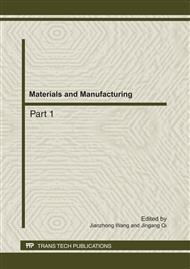p.139
p.143
p.147
p.151
p.155
p.159
p.163
p.167
p.171
Effects of the Valence Electron Structures of Nitride on Cold Shortness in Steel
Abstract:
Up to now, most of work focused on the grain boundary segregation and the cold shortness caused by non-metallic element of nitrogen had been done. However, it is not clear that the reasons why the nitrogen element can generate the grain boundary segregation and the cold shortness at electron structural level. Therefore, based on the empirical electron theory of solids and molecules(EET), valence electron structures of α-Fe-N, Fe4N and AlN were calculated, and the cold shortness generated by the nitrogen element as well as the removal mechanism of cold shortness with the help of Al element were analyzed with the phase structure factor nA. It was found that the phase structure unit of α-Fe-N with bigger nA firstly segregates on grain boundary,then the Fe4N with smaller nA on grain boundary was precipitated from supersaturated solid solution α-Fe-N, resulting in the formation of Fe4N+α-Fe hybrid followed by the cold short in steel. However, because the value of AlN is larger than that of TiN and VN, the addition of Al element can make the cold shortness starting point decrease distinctly and thus result in the removal of segregation of nitrogen and cold shortness generated by Fe4N. The results analyzed with the EET were in agreement with experimental fact.
Info:
Periodical:
Pages:
155-158
Citation:
Online since:
July 2011
Authors:
Keywords:
Price:
Сopyright:
© 2011 Trans Tech Publications Ltd. All Rights Reserved
Share:
Citation:


